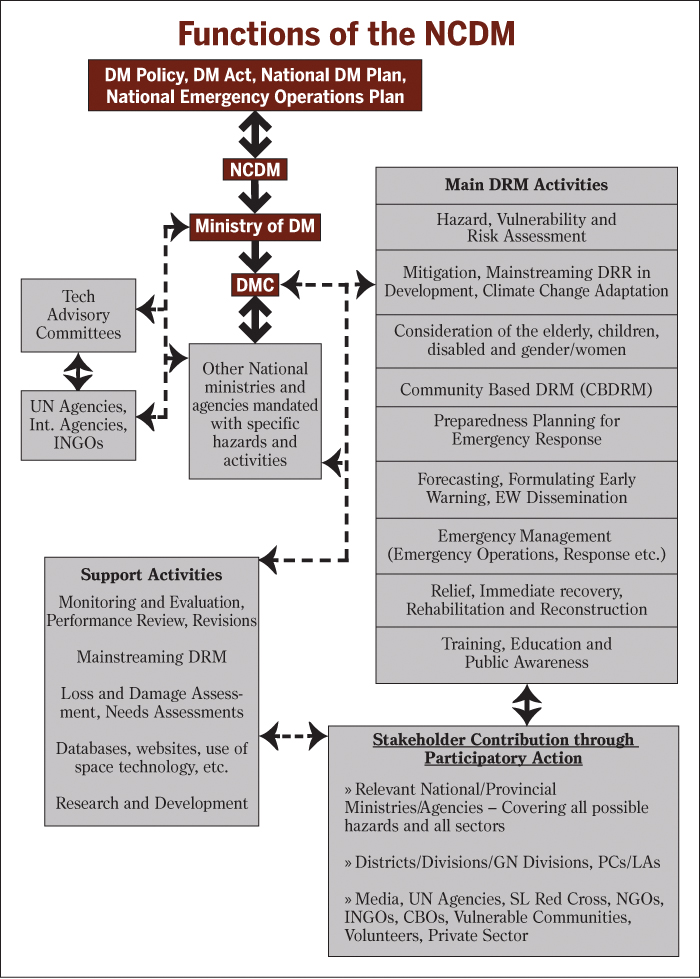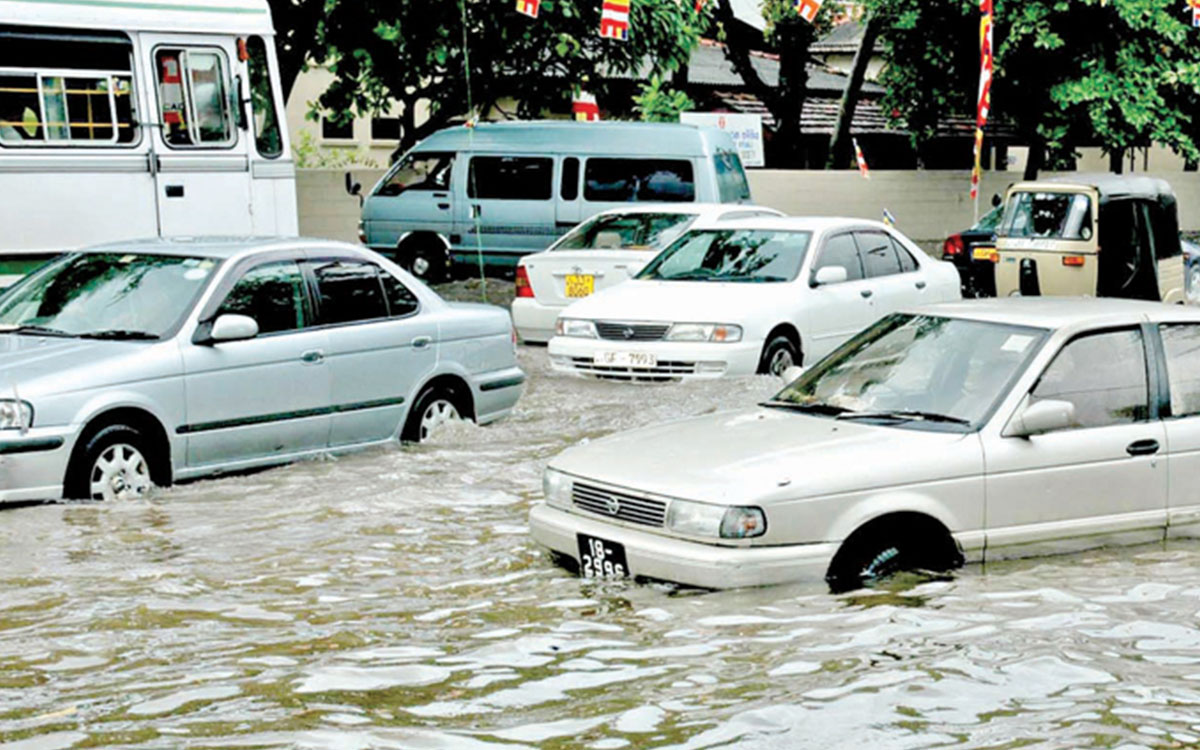A report was released very recently titled, Disaster Management in Sri Lanka: A CASE STUDY OF ADMINISTRATIVE FAILURES. The Economics Research Team of Verité Research compiled this study.
The purpose of this piece is to use some of the details and highlight areas in which we could do well to implement and use the platform provided by the National Council for Disaster Management (NCDM).
A unique feature unknown to many is the use of the Reconstruction and Rehabilitation Fund.
The Board of Governors include
(a) The Prime Minister;
(b) The Minister in charge of the subject of Reconstruction, Rehabilitation and Social Welfare;
(c) The Speaker;
(d) The Leader of the Opposition;
(e) The Secretary to the Prime Minister;
(f) The Secretary to the Treasury or his nominee; (g) The Secretary to the Ministry of the Minister in charge of the subject of Reconstruction, Rehabilitation and Social Welfare; and
(h) Two other members appointed by the Prime Minister, each of whom shall, subject to the provisions of subsections (3) and (4), hold office for such period as may be specified in the letter of appointment issued to him by the Prime Minister.
(3) The Prime Minister may in his absolute discretion revoke the appointment of any member appointed by him under paragraph (h) of subsection (2).
(4) Any member of the Board appointed under paragraph (h) of subsection (2) may at any time resign from the Board by letter in that behalf addressed to the Prime Minister.
(5) The Board may regulate the procedure in regard to its meetings and the transaction of business at such meetings.
(6) No act or proceeding of the Board shall be deemed to be invalid by reason only of the existence of a vacancy among its members or any defect in the appointment of a member thereof.
(7) The Prime Minister shall be the Chairman of the Board.
Sri Lanka enacted legislation in 1993 to give effect to this Fund. The composition of the Governing Board shows the multi-partisan character.
The Fund has several features.
(1) The Board shall maintain an account called “The Reconstruction and Rehabilitation Fund Account” at the Central Bank and there shall be credited to such account
(a) All sums of money that may accrue to the Fund after the date of commencement of this Act;
(b) All sums of money that may be received by the Fund, by way of donations, grants or gifts from any source whatsoever.
(2) It is hereby declared that a donation in money to the Fund is, for the purpose of the application of the Inland Revenue Act, No. 28 of 1979, a donation made in money to a Fund established by the Government.
Purposes for which the money of the Fund may be applied
It shall be the duty of the Board to apply the money belonging to the Fund in such manner as the Board may determine, subject to the directions of the Prime Minister;
(a) for the relief of persons affected by any disaster;
(b) for the reconstruction of property affected by any disaster;
(c) for the rehabilitation of property or persons affected by any disaster;
(d) for any other purpose connected with the prevention of any disaster or mitigation of the effects of any disaster.
This Fund could easily have been used after the Tsunami effectively collecting the huge quantum’s pledged but wasted by us from external Governmental and internal sources with a bulk not reaching Sri Lanka. On every occasion after the ceasefire in 2002 or after 2009 the Fund would have been a credible transparent vehicle for collection and distribution of Funds for the objectives laid out post-disasters.
The need exists even now be it for residual work in former conflict areas and communities and the ongoing imperatives resulting from climate change and natural disasters.
This writes loathes and is cynical of the approach to interventions which are about multiple meetings hosted in hotels, vast amounts spent on reports with very little intervening and impacting on where greatest need is found.
An example what we could do includes-
Knowledge Hubs
Discover knowledge to help practitioners: Track current thinking in writings, enhance skills and expertise, comparing and sharing information and data.
Connect with local experts and network: Developing and retaining specialized local knowledge, sharing success stories, networking and collaborating with the likeminded.
Generate new ideas: Inspiring innovation, learning from experts in the field.
Volunteer force -We need volunteers to help: conserve and protect our natural environment; support and encourage more sustainable behaviour in our communities and mitigate against impact of climate change and other natural disasters.
Investing time: with plant cultivation, educating local communities about the importance of protecting the environment, restoring mangroves, de-silting small catchments, transferring knowledge to mitigate against impact of climate change.
****
Functions of the National Council for Disaster Management
1. Formulate a national policy and programme on the management of disasters.
2. Prepare and formulate the National Disaster Management Plan and the National Emergency Operation Plan.
3. Monitor the implementation of the National Disaster Management Plan and the National Emergency Operation Plan.
4. Facilitate emergency response, recovery, relief, rehabilitation and reconstruction in the event of any disaster.
5. Take all steps to counter any disaster or impending disaster, in accordance with the plans.
6. Direct, co-ordinate and monitor the activities of the Disaster Management Center and the appropriate organisations.
7. Ensure that adequate publicity is given to the National Disaster Management Plan and the National Emergency Operation Plan.
8. Specify guidelines to be complied with by every Ministry, Government Department and public corporation in the preparation of Disaster Management Plans under section 10.
9. Promote public awareness campaigns relating to disaster management and funding of research and development on disaster management.
10. Facilitate and support local and community self-reliance in the event of any potential or actual disaster.
11. Facilitate liaison with organisations and persons pursuing hazard, vulnerability and risk reduction studies and implementing action programmes and commissioning such studies and action programmes.
12. Assign functions and responsibilities to the Disaster Management Centre (DMC).
13. Initiate programmes relating to prevention and mitigation of disaster and the provision of relief, rehabilitation and reconstruction.
14. Appraise the Cabinet of Ministers on all relevant matters connected with any potential and actual disasters.
15. Recommend the allocation of funds for disaster management from the relevant authorities and bodies and the Reconstruction and Rehabilitation Fund Act, No. 58 of 1993.

